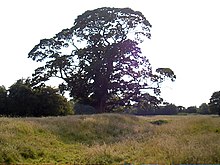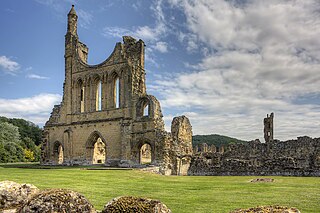
Byland Abbey is a ruined abbey and a small village in the Ryedale district of North Yorkshire, England, in the North York Moors National Park.
Thomas Walsingham was an English chronicler, and is the source of much of the knowledge of the reigns of Richard II, Henry IV, Henry V and the latter reign of Edward III depicting the decline of the state of affairs of the English. He also documented the careers of John Wycliff and Wat Tyler.
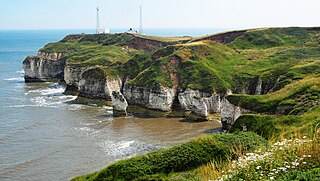
The East Riding of Yorkshire, often abbreviated to the East Riding or East Yorkshire, is a ceremonial county in the Yorkshire and the Humber region of England. It borders North Yorkshire to the north and west, South Yorkshire to the south-west, and Lincolnshire to the south across the Humber Estuary. The city of Kingston upon Hull is the largest settlement.

Holderness is an area of the East Riding of Yorkshire, on the north-east coast of England. An area of rich agricultural land, Holderness was marshland until it was drained in the Middle Ages. Topographically, Holderness has more in common with the Netherlands than with other parts of Yorkshire. To the north and west are the Yorkshire Wolds. Holderness generally refers to the area between the River Hull and the North Sea. The Prime Meridian passes through Holderness just to the east of Patrington and through Tunstall to the north.

Sir Edward Augustus Bond was an English librarian.
This is a list of people who have served as Lord Lieutenant for the East Riding of Yorkshire. The office was established after the English Restoration in 1660, when a Lord Lieutenant was appointed for each Riding of Yorkshire. Since 1721, all Lord Lieutenants have also been Custos Rotulorum of the East Riding of Yorkshire, and for part of the period also Lieutenants of the Town and County of the Town of Kingston upon Hull. It was abolished on 31 March 1974 with the creation of the county of Humberside, but was re-created upon the abolition of Humberside on 1 April 1996.

Cottingham is a large village and civil parish in the East Riding of Yorkshire, England. It lies 4 miles (6 km) north-west of the centre of Kingston upon Hull, and 6 miles (10 km) south-east of Beverley on the eastern edge of the Yorkshire Wolds. It forms part of Hull's Urban Area. It has two main shopping streets, Hallgate and King Street, which cross each other near the Church of Saint Mary the Virgin, and a market square called Market Green. Cottingham had a population of 17,164 residents in 2011, making it larger by area and population than many towns. As a result, it is one of the villages claiming to be the largest village in England.

Ravenser Odd, also spelled Ravensrodd, was a port in the East Riding of Yorkshire, England, during the medieval period, built on the sandbanks at the mouth of the Humber estuary.

Baynard Castle was a moated castle built in the 12th and 13th centuries in the village of Cottingham, East Riding of Yorkshire, England. It was referred to by terms including the 'castle at Cottingham' or 'Stuteville's castle'; the term Baynard Castle is common in 19th-century references and later.
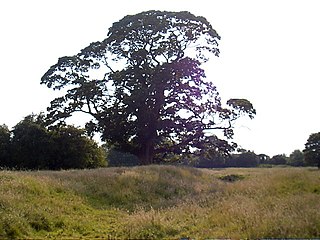
Meaux is a hamlet and former civil parish, now in the parish of Wawne, in the East Riding of Yorkshire, England. It is about 6+1⁄2 miles (10 km) north of Hull city centre and 3+1⁄2 miles (6 km) east of Beverley. In 1931 the parish had a population of 73.
Reinald Macer [also called Reginald] was a medieval Cistercian monk and bishop, active in the Kingdom of Scotland during the reign of William the Lion. Originally a monk of Melrose Abbey, he rose to become Bishop of Ross in 1195, and held this position until his death in 1213. He is given the nickname Macer in Roger of Howden's Chronica, a French word that meant "skinny".
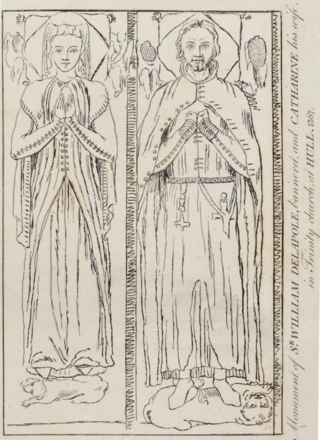
Sir William de la Pole was a wealthy wool merchant from Kingston upon Hull in Yorkshire, England, who became a royal moneylender and briefly served as Chief Baron of the Exchequer. He founded the de la Pole family, Earls of Lincoln, Earls of Suffolk and Dukes of Suffolk, which by his mercantile and financial prowess he raised from relative obscurity to one of the primary families of the realm in a single generation. At the end of the 14th century he was described in the 'Chronicle of Melsa' as "second to no other merchant of England". He was the founder of the Charterhouse Monastery, Kingston upon Hull.
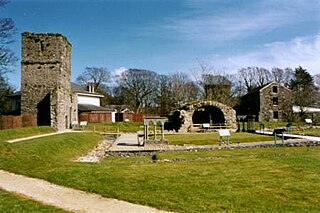
William Russell was a fourteenth-century Cistercian prelate. He appears to have begun his career as a Cistercian monk at Rushen Abbey on the Isle of Man (Mann), ascending to the rank of abbot there, before being elected Bishop of Mann and the Isles (Sodor). After traveling to Continental Europe for confirmation and consecration, avoiding a trip to the metropolitan in Norway, he returned to the Irish Sea as a legal bishop. A few things are known of his episcopate, particularly his activities in England and a series of provincial statutes apparently promulgated under his leadership.

Louth Park Abbey was a Cistercian abbey in Lincolnshire, England. It was founded in 1139 by the Bishop Alexander of Lincoln as a daughter-house of Fountains Abbey, Yorkshire.

The Charterhouse was a Carthusian monastery and almshouse in Kingston upon Hull, England, built just outside the town's walls. The hospital building survived the Dissolution of the Monasteries; the priory was destroyed in 1538. The structure of the hospital was destroyed before the first siege of Hull during the English Civil War. A replacement was built in 1645, which was replaced again in 1780; the buildings function as an almshouse with an attached chapel, and remain in use to the present day (2012).
Lime Kiln Creek was an outlet onto the Humber Estuary in Kingston upon Hull, England, thought to be a previous outlet of the River Hull onto the estuary. It was blocked off during the construction of the Albert Dock in the 1860s.
Drogo de la Bouerer was a Flemish associate of William the Conqueror, who was rewarded after the conquest with a large grant of land in northern and eastern England, primarily in Holderness, where he built Skipsea Castle.
The Dieulacres Chronicle is a 14th-century English chronicle that was written at the Cistercian Dieulacres Abbey in Staffordshire. It has three parts: the first is a description of England that borrows from Bede, Ranulf Higden and Gerald of Wales; the second is a history of the earls of Chester and Dieulacres Abbey dating to the 13th century; and the third is a history of England spanning the years from 1337-1403. After Henry Bolingbroke and Thomas Arundel invaded England and deposed Richard II, a number of chronicles, including Dieulacres were edited by newly appointed scribes to support Henry's Lancastrian claim to the throne.
Simon Binham or Bynham was an English chronicler and Benedictine monk of the priory of Binham, Norfolk. He assisted the prior of Binham in opposing the exactions of Hugh, abbot of St. Albans, and was imprisoned for some time with the other rebellious monks. He is said to have contributed to the continuation of the Chronicle of Rishanger, but his other writings are largely lost.
